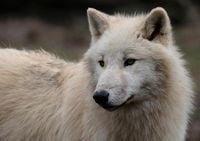The dire wolf (Aenocyon dirus), a North American canine that went extinct approximately 13,000 years ago, has recently become a hot topic in both scientific and popular culture circles. This renewed interest follows claims by Colossal Biosciences, an American biotechnology company, that it has successfully brought the dire wolf back from extinction. The announcement was made in a press release dated April 7, 2025, and has ignited a debate over the authenticity of their claims.
Colossal Biosciences, co-founded by tech entrepreneur Ben Lamm and Harvard geneticist George Church, announced the birth of three genetically-engineered puppies: Khaleesi, Romulus, and Remus. These pups are said to be the result of a groundbreaking effort to revive a species that has been extinct for millennia. According to Colossal, this achievement represents a historic milestone, with Lamm stating that they have "accomplished something that’s never been done before: the revival of a species from its longstanding population of zero." The puppies were born during the fall and winter seasons of late 2024 and early 2025.
To create these puppies, Colossal utilized DNA preserved in a 13,000-year-old tooth and a 72,000-year-old skull to construct two dire wolf genomes. The researchers then compared these genomes to that of the gray wolf (Canis lupus) and identified 20 differences in 14 genes that account for the phenotypical distinctions between the two species. Using CRISPR technology, they edited the genetic material of endothelial progenitor cells (EPCs) harvested from living gray wolves, transferring the modified nuclei into denucleated gray wolf ova to create embryos, which were then implanted in surrogate mothers.
However, the announcement has drawn skepticism from various experts in the field. Dr. Philip, a zoologist from the University of Otago, remarked that the puppies are merely "genetically engineered gray wolves," while paleogeneticist Dr. Nic Rawlence emphasized that dire wolves and gray wolves belong to completely different genera. He further clarified that while Colossal identified 20 changes in 14 genes, the dire wolf is genetically distinct from the gray wolf by thousands of genes.
Dr. Jacquelyn Gill, a paleoecologist at the University of Maine, expressed concern that the puppies do not possess any traits that would help us understand the dire wolf better than we did before. Similarly, Dr. Adam Boyko, a geneticist at Cornell University, pointed out that the puppies are not being raised in environments that would allow them to learn behaviors typical of dire wolves.
In an April 18 statement, the International Union for Conservation of Nature (IUCN) Species Survival Commission (SSC) reiterated that the dire wolf and gray wolf are genetically distinct, stating that Colossal's gene editing was limited to only a handful of genes, which raises questions about the validity of their claims. They concluded that the puppies produced by Colossal do not qualify as dire wolves nor as proxies for them based on their guiding principles for extinct species.
Colossal has defended its methods by stating that they are using a morphological species concept, asserting that the puppies look and act like dire wolves. Chief Science Officer Dr. Beth Shapiro acknowledged that creating an identical dire wolf is not feasible but maintained that the goal is to produce an organism that resembles the extinct species. Colossal's official Reddit account echoed this sentiment, emphasizing that the definition of species is a human construct and that their creations are valid because they exhibit dire wolf-like characteristics.
Despite the controversy, Colossal's announcement has captured public attention, especially given the dire wolf's cultural significance, particularly through its portrayal in HBO’s "Game of Thrones." To highlight this connection, Colossal photographed two of the puppies on the Iron Throne prop used in the series, which was lent to them by director Peter Jackson, a Colossal investor. Additionally, George R.R. Martin, the creator of "Game of Thrones," has also invested in Colossal and visited the puppies at their private compound.
Colossal's ambitions extend beyond the dire wolf. The company plans to revive other extinct species, including the woolly mammoth, the Tasmanian tiger, and the dodo. It has raised over $435 million in venture capital funding to support these efforts. Notably, Colossal has also cloned two litters of red wolves, the most critically endangered wolves in the world, as part of its conservation initiatives.
Critics of Colossal's approach caution that the focus on de-extinction might divert resources from existing conservation efforts for endangered species. Lamm has countered this claim, asserting that the company’s work brings new funding into conservation efforts rather than taking away from them. He emphasized that the technologies developed by Colossal are open-source, meaning they can be shared with conservationists working to protect living species.
As Colossal forges ahead with its projects, ethical considerations loom large. The company has been asked about the implications of potentially creating mythical or fictional beings in the future, such as a living Neanderthal or even a Pikachu. Lamm stated that while the technology may one day allow for such creations, the current focus remains on reviving extinct species, which presents its own set of challenges.
In summary, while Colossal Biosciences claims to have revived the dire wolf, the scientific community remains divided on the validity of these assertions. As the debate unfolds, the implications of genetic engineering and de-extinction continue to provoke thought and discussion about the future of conservation and biodiversity.


